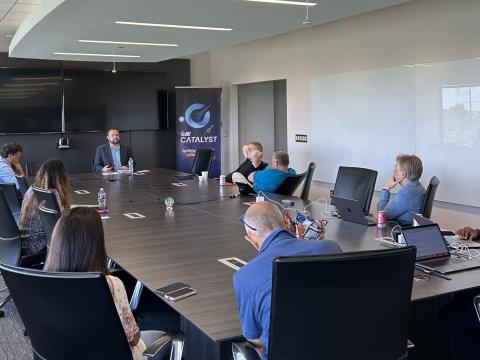Healthy Cloud Migration
Experts at the Defense Health Agency (DHA) and the Program Executive Office, Defense Healthcare Management Systems, recently completed a game-changing cloud migration project that digitally transformed access to Defense Department medical records. The so-called Accelerated Migration Project, or AMP, was a vast data migration of petabytes of secondary healthcare data to the cloud. The effort involved working with 20 outside vendors, restructuring to 14 cloud native services, managing 60 separate applications and consolidating several hundred virtual machines.
For its government cloud, AMP is relying on commercial cloud hosting services through Amazon Web Services (AWS), and Sharepoint (Carepoint), Qlik, Tableau and others for its user interface. These companies told the DHA team that AMP was a record-breaking project in terms of capacity.
The platform serves clinicians, medical treatment facilities, civilian facilities, the DOD, the Department of Veterans Affairs, data scientists and analysts. The new health data delivery system will enable greater understanding of DOD medical data and allows for more confidence in the data’s validity, according to experts.
In addition to higher levels of sustainability and reliability, the system offers increased capabilities—"better tools, better use of tools, more tools and improved user access,” said Chris Nichols, program manager for the Enterprise Intelligence & Data Solutions (EIDS), Program Executive Office, Defense Healthcare Management Systems (PEO DHMS). The DHMS reports directly to the Office of the Under Secretary of Defense for Acquisition and Sustainment, and administratively is attached to DHA. “We’re getting the right data, in the right hands at the right time, which allows it to be actionable and impact decision making,” he stated.
DHA was facing an aging legacy medical system with limited capacity, located in an on-premise data center in Charleston. “We were looking down the barrel of hardware refreshes of over 300 servers,” Nichols said. “And we couldn’t just lift and shift.”
Besides the enormous scope and scale of the project, another remarkable aspect of AMP was the DHA team’s speed in completing it—93 days.
AMP was originally planned to take a year-and-a-half but given the urgency of the pandemic and the potential equipment failure of legacy systems, EIDS and other experts sprang into action. “This work was not scheduled to get done until about this time next year,” Nichols said. “The speed-to-market that we accomplished via this project is ground-breaking. “We moved from 18 months to 93 days, and we proved that if we build strong partnerships and an all-hands-on-deck mentality with vendors and federal counterparts, we can accomplish seemingly impossible things.”
“Usually, we see government organizations take 2 to 3 years for this type of project, so the way that Chris and his team executed is pretty special,” adds Justin Fanelli, chief architect, EIDS PMO and technical director, Navy Manpower, Personnel, Training and Education, at the service’s Navy Information Warfare Center. He helped steer AMP’s engineering and architecture for the DHA team, a group which also included engineering and technical staff, a cyber team and data innovation driven by clinicians, including pharmacists, physicians and data scientists. Nichols himself served in the Army as a combat medic, licensed practical nurse and officer.
The project also benefited from top leadership support at DHA, with Director Lt. Gen. Ronald Place, USA, making it a focus for the young agency, which stood up seven years ago as a joint, integrated combat support agency to manage all of the service’s garrison healthcare for Military Health System (MHS) beneficiaries. Before then, each service managed its own electronic health care records.
“We got an agreement from the agency’s director, Gen. Place, to make this a priority in mid- February and we met in the first week of March in Charleston,” Nichols said. “And we turned on everything in AWS on May 31, and we turned off and disconnected the legacy environment on the 12th of June.”
The team secured multiple authority to operate (ATO) decisions in rapid fashion, an uncommon feat. For that accomplishment, the project leads relied on a team of teams—assistance from DHA J6, Joint Staff; DISA; several Navy Commands for cyber, technical and operations; and interface partners, such as the Coast Guard and others, explained Fanelli. “Every service was involved, certainly,” he said. “And with all of the organizations on the same page and pressing teams, we were able to execute four ATOs in less than four months.”
It also helped that Nichols had previously inherited the beginnings of a pathfinder project that moved a small knowledge exchange system from Air Force Medicine into DHA, using AWS. That project helped DHA feel comfortable from a cyber and infrastructure perspective to move towards cloud services, Nichols noted, “because we had not really done that yet. And [with AMP], because we are the secondary data holder for this very large healthcare system, we kind of pushed the bubble. We kept pushing and said if we don't do this now, here are the second order of effects that we're going to have to deal with.”
As for advice to other government personnel pursuing such a cumbersome project, the experts suggested that setting up the right environment to pursue AMP was crucial. “We got the principles right up front, and we got buy-in from this wide group of people and organizations,” Fanelli said. “Then from there, the architecture, the security and the documentation were a very natural outpouring because of the buy-in of principles, and the culture perpetuated itself. People were very accountable and they wanted to be involved.”
That enthusiasm was contagious, Nichols added. “An impossible challenge is something really talented people rise to meet,” he offered. “Know and connect with your teams and the teams under those teams. And trust people to do their job.”
And while budgetary concerns are always part of managing a project, Nichols advised officials to look at the second and third order effects of every cost with an eye toward impacting the future of clinical care, being a data-driven organization and positioning the organization around impactful capabilities such as in artificial intelligence, machine learning and overall digital transformation. “To drive towards a federal healthcare data hub, we must not be penny wise and pound foolish,” he stated.
Fanelli emphasized that the federal government can be a source of record-breaking speed and platform innovation, and that “doing a project faster and focused with improved and lasting outcomes doesn’t have to make it tremendously more expensive.”




Comments